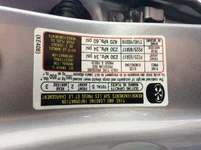The Owner's Manual doesn't provide a reason why they recommend an additional 4.3 psi for winter tires but I've been doing this for years for reasons I discovered on my own.
If I run winter tires at the pressures listed on the placard, they build too much heat during highway driving on bare and dry roads. This causes the winter rubber compound to continue to cure which makes it unsuitable for winter driving. If I know I will be driving entirely on snow/ice AND I will not be carrying a load, I will reduce the pressure to as low as 34-35 psi. for increased traction but I always insure they are aired back up before fast travel on bare and dry pavement. In actuality, with winter tires, it is generally not necessary to decrease pressure since there is an abundance of traction even at 38 psi. All-season radials are susceptible to the rubber compound over-cooking as well (although to a lesser degree) which is why I run at least 3 psi over the pressure listed on the placard. I also achieve more even tread wear from side to side.



